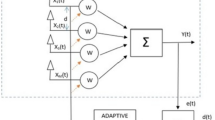Abstract
Side information (SI) detection is normally needed to achieve successful data reception when selected mapping is implemented for reducing peak-to-average power ratio in orthogonal frequency division multiplexing systems. In severe frequency selective channel fading, existing pilot-assisted SI estimation schemes are ineffective especially when the number of pilots is limited, resulting in performance degradation in the form of increased BER. To address this problem, an alternative pilot-assisted SI estimation method based on a time-domain decision metric is proposed. Simulations show that when compared to a pilot-assisted SI estimation scheme based on frequency domain correlation, the proposed method provides improved SI estimation performance in the form of reduced SI detection error rate.




Similar content being viewed by others
References
Miridakis, N. I., & Vergados, D. D. (2013). A survey on the successive interference cancellation performance for single-antenna and multiple-antenna OFDM systems. IEEE on Communications Surveys Tutorials, 15(1), 312–335.
Armstrong, J. (2009). OFDM for optical communications. Journal of Lightwave Technology, 27(3), 189–204.
Adegbite, S., Stewart, B. G., & McMeekin, S. G. (2013). Least Squares interpolation methods for LTE system channel estimation over extended ITU channels. International Journal of Information and Electronics Engineering, 3(4), 414–418.
Alsusa, E., & Yang, L. (2008). Redundancy-free and BER-maintained selective mapping with partial phase-randomising sequences for peak-to-average power ratio reduction in OFDM systems. IET Communications, 2(1), 66–74.
Adegbite, S.A., McMeekin, S.G., & Stewart, B.G. (2014). Deterministic Sequences From a Fibonacci Series For PAPR Reduction in SLM-OFDM Systems. In: Proceedings of the 2014 Europment International Conference on Communications, Signal Processing and Computers (CSPC), Interlaken (pp. 54–59).
Bumman, K., Junghwan, M., & Ildu, K. (2010). Efficiently amplified. IEEE Microwave Magazine, 11(5), 87–100.
Baig, I., & Jeoti, V. (2013). A ZCMT precoding based multicarrier OFDM system to minimize the high PAPR. Wireless Personal Communications, 68(3), 1135–1145.
Lee, B. M., de Figueiredo, R. J., & Kim, Y. (2012). A computationally efficient tree-PTS technique for PAPR reduction of OFDM signals. Wireless Personal Communications, 62(2), 431–442.
Jiang, T., & Wu, Y. (2008). An overview: Peak-to-average power ratio reduction techniques for OFDM signals. IEEE Transactions on Broadcasting, 54(2), 257–268.
Lim, D.-W., Heo, S.-J., & No, J.-S. (2009). An overview of peak-to-average power ratio reduction schemes for OFDM signals. Journal of Communications and Networks, 11(3), 229–239.
Rahmatallah, Y., & Mohan, S. (2013). Peak-to-average power ratio reduction in OFDM systems: A survey and taxonomy. IEEE on Communications Surveys Tutorials, 15(4), 1567–1592.
Baxley, R., & Zhou, G. (2007). Comparing selected mapping and partial transmit sequence for PAR reduction. IEEE Transactions on Broadcasting, 53(4), 797–803.
Hasan, M. M. (2013). VLM precoded SLM technique for PAPR reduction in OFDM systems. Wireless Personal Communications, 73(3), 791–801.
Jayalath, A. D. S., & Tellambura, C. (2005). SLM and PTS peak-power reduction of OFDM signals without side information. IEEE Transactions on Wireless Communications, 4(5), 2006–2013.
Le Goff, S. Y., Al-Samahi, S. S., Khoo, B. K., Tsimenidis, C. C., & Sharif, B. S. (2009). Selected mapping without side information for PAPR reduction in OFDM. IEEE Transactions on Wireless Communications, 8(7), 3320–3325.
Park, J., Hong, E., & Har, D. (2011). Low complexity data decoding for SLM-based OFDM systems without side information. IEEE on Communications Letters, 15(6), 611–613.
Hong, E., Kim, H., Yang, K., & Har, D. (2013). Pilot-aided side information detection in SLM-based OFDM systems. IEEE Transactions on Wireless Communications, 12(7), 3140–3147.
Bauml, R. W., Fischer, R. F. H., & Huber, J. B. (1996). Reducing the peak-to-average power ratio of multicarrier modulation by selected mapping. Electronics Letters, 32(22), 2056–2057.
Peled, A., & Ruiz, A. (1980). Frequency domain data transmission using reduced computational complexity algorithms. IEEE International Conference on ICASSP ’80 Acoustics, Speech, and Signal Processing, 5, 964–967.
Cho, Y. S., Kim, J., Yang, W. Y., & Kang, C. G. (2010). MIMO-OFDM wireless communications with MATLAB. Hoboken: Wiley.
Adegbite, S. A., McMeekin, S. G., & Stewart, B. G. (2014). Low-complexity data decoding using binary phase detection in SLM-OFDM systems. Electronics Letters, 50(7), 560–562.
Cooley, J. W., & Tukey, J. W. (1965). An algorithm for the machine calculation of complex Fourier series. Mathematics of Computation, 19(90), 297–301.
Johnson, S. G., & Frigo, M. (2007). A modified split-radix FFT with fewer arithmetic operations. IEEE Transactions on Signal Processing, 55(1), 111–119.
Failli, M. (1989). Digital land mobile radio communications COST 207, ETSI, Technical Report, European Commission.
3GPP Technical Specification (TS) 36.101 v12.0.0. (2013). Evolved Universal Terrestrial Radio Access (EUTRA); User Equipment (UE) Radio Transmission and Reception (Release 12).
3GPP Technical Specification (TS) 36.211 v12.0.0. (2013). Evolved Universal Terrestrial Radio Access (EUTRA); Physical Channels and Modulation (Release 12).
3GPP Technical Specification (TS) 36.212 v12.0.0. (2013). Evolved Universal Terrestrial Radio Access (EUTRA); Multiplexing and Channel Coding (Release 12).
Author information
Authors and Affiliations
Corresponding author
Rights and permissions
About this article
Cite this article
Adegbite, S.A., McMeekin, S.G. & Stewart, B.G. Time-Domain SI Estimation for SLM Based OFDM Systems Without SI Transmission. Wireless Pers Commun 85, 1193–1203 (2015). https://doi.org/10.1007/s11277-015-2834-z
Published:
Issue Date:
DOI: https://doi.org/10.1007/s11277-015-2834-z




